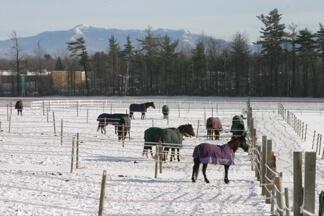Despite unprecedented budget cuts in the works, the College of Agriculture and Life Sciences (CALS) will move ahead to reorganize and ultimately invest some $14 million into its farms, officials confirmed the first week of the new year.
The news came after Vermont's land-grant college sustained more than $100,000 in state cutbacks for the current fiscal year and another $400,000 slated for FY2010, as part of university-wide and state budget cuts. More cuts may be coming.
"The changing economy will factor in the phasing of such an extensive project, however, the time to act is now," said CALS Interim Dean Tom Vogelmann. "We cannot continue as is. It is important that University of Vermont farms synchronize with the College's and the University's master plans," he said. "And we want to be ready to go when things change economically for the university."
The Paul Miller Complex, known as UVM Farms, has been costing $1.2 million each year, reported Richard "Skip" Fanus, assistant dean of finance for the College.
Reworking the farms' budget is the first step to a comprehensive plan to get the farms back on track, then rebuild them to flourish as a model for Vermont agriculture.
The process was set in motion on Oct. 17, when the CALS advisory board voted unanimously that the College move forward to reorganize its dairy and horse farms on Spear Street and UVM Horticultural Research Farm on Green Mountain Drive in South Burlington. The advisory board and others acknowledged the position of the animal sciences department, which has voiced several concerns with the concept.
At that meeting CALS advisory board chair Cynthia Danaher recognized that "the farm is one of many worthy projects on UVM's horizon, CALS has greatly benefited from recent University-supported projects, and we are all aware of the uncertain economic times our country faces." She continued, but we felt it was still important to be in process on the farm plan for the future."
Next, UVM's board of trustees voted Dec. 8 to put farm reorganization on the list of UVM-approved projects. That's the go-ahead for CALS to fundraise and begin to create plans and drawings.
Just getting on "the list," follows a year-long study that included: details of financial losses, input from stakeholders and a panoply of brainstorms for what the farms could become. Rough estimates for these ideas total nearly $14 million, according to the 41-page project summary.
The next steps: Vogelmann will continue to receive ideas, and a committee will begin plans. "All ideas are measured against CALS' desire to best serve our students with courses and hands-on experiences, optimize the growing season, not duplicate nearby universities' efforts and run efficient and sustainable operations," he said. "Our ideal is to find research niches that serve students, faculty and Vermonters, while cultivating the strengths of the College's research scientists."The reaction from key corners of Vermont agriculture has been positive so far.
"This is a very important decision that moves the College forward to help the farmers of Vermont including traditional dairy farmers," said Roger Allbee, secretary of Vermont Agency of Agriculture, and a CALS advisory board member.
"I'm pleased that it was a unanimous endorsement of the concept in principle. Much discussion focused on the need to support all segments of agriculture, with a specific emphasis on traditional commercial agriculture," agreed Robert Foster, a CALS advisor and owner of Vermont Natural Agricultural Products, Inc., better known as the maker of Moo Doo. Foster noted that "many of the specific details of the plan will need to be fleshed out to take into account, funding, student programs, research objectives -- all of which will need further community dialogue."
CAPTION: Hardacre Farm, part of UVM's Paul Miller Research Complex of farms off Spear Street in South Burlington boasts terrific views of Mount Mansfield. ~Cheryl Dorschner photo

Revitalizing UVM's Farms Could Help CALS Budget and Vermont Agriculture
ShareJanuary 14, 2009